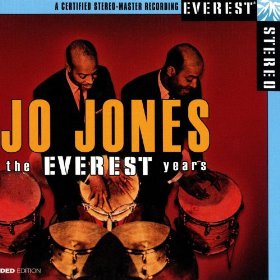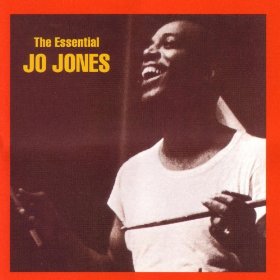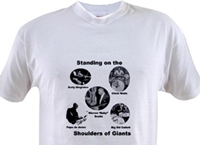I'll get some ancillary recommendations out of the way first. See my 9 August 2012 post titled My Personal Rushmore for a listing of box value-priced box sets in which Papa Jo Jones occupies a substantial number of tracks. The box sets are compilations of these artists: Billie Holiday, Teddy Wilson, Lester Young and Count Basie. Indeed, those artists form a mesh where Papa Jo is the is the common thread.
Two other posts that should interest any Papa Jo fan are my 20 July 2012 post, Rifftide: The Life and Opinions of Papa Jo Jones - A Review and a related piece posted on 28 July 2012 titled Papa Jo Jones revisited. Both of those posts contain links to even more content, so if you have the time to peruse this material you will come away with a lot of background information that includes audio and video clips.
The first album in my list of recommendations is The Everest Years

This is actually two albums combined into a value-priced compilation:
Album #1 is Jo Jones Trio. This circa 1959 album features a tight trio comprised of Papa Jo Jones, backed by brothers Ray Bryant on piano and Tommy Bryant on bass.
The first 12 tracks that are from this album are particularly excellent for studying Papa Jo's brush technique. One reason is there are no horns or large ensembles to mask every legato note he plays. What I especially love about this for study purposes is how he treats 'I Got Rhythm' in tracks 8 (Part I) and 9 (Part 2). The first is a relatively slow tempo, with the second at a much faster tempo. The contrast in brush techniques for each tempo is an invaluable lesson in itself.
Here are two of the tracks from the album to give you an idea of the music:
Vamp Till Ready is the second album from the Everest years that comprises this album. This was recorded circa 1960 (some sources cite 1959 with a 1960 release), and it consists of the final 12 tracks featuring Harry Sweets Edison on trumpet, Jimmy Forrest on tenor saxophone, Bennie Green on trombone, Tommy Flanagan on piano and Tommy Potter on bass. These tracks are also excellent study material because they capture Papa Jo's deft touch and beautiful dynamics in a larger ensemble setting.
Of course, you do not have to be a drummer to appreciate this album because the music stands on its own merits. And a piece of trivia: Jimmy Forrest, tenor saxophonist on the last 12 tracks, is the composer of Night Train an iconic R&B hit made famous by James Brown.
\Next up is Our Man, Papa Jo! +4

This album showcases Papa Jo's like few others because every note and nuance of his playing can be heard.
The album itself was recorded at Sound Ideas Studios in New York City on 12 December 1977. The Japanese label, Denon, issued it as an import circa 1982 and it has been in and out of print in the US since then.
My interest in Papa Jo's recordings are mainly to study his brushwork. However, he plays with sticks on many of the tracks in this one. His deft touch and practically patented hi-hat patterns lift the ensemble the same way as in his Basie days when he and the rest of the All American Rhythm Section invented that technique. As a drummer this is a treasure. As a lover of solid jazz this is a great listen that extends to bring pleasure to musicians and casual listeners alike.
The ensemble backing Papa Jo includes Hank Jonesn on piano, Major Holley on bass and Jimmy Oliver on tenor. Holley seems to have escaped the wider fame he richly deserves as a bassist. He had played with just about every top jazz musician in his career and was highly regarded, but managed to fall into obscurity. Sound samples for this album are on this page
The aptly titled The Essential Jo Jones is just that: essential:

This is a compilation of the only two albums Papa Jo led for Vanguard. The first is Jo Jones Special (Vanguard VRS 8503) recorded August 11 and 16, 1955, and he second is the long out of print Jo Jones Plus Two (Vanguard VRS 8525) recorded April 30, 1958.
The first six tracks are from Jo Jones Special and the first of those tracks is one of the two very special ones on this album. That first track, Shoe Shine Boy reunites the All American Rhythm Section - Basie on piano, Freddie Green on guitar, Walter Page on bass and Papa Jo on drums - for their last performance together. Unfortunately I have no clip of that rendition, but have a different performance of the same song that displays Papa Jo's approach to playing it:
Other musicians on those first six tracks are Nat Pierce on piano for the remaining tracks 2-6, Emmett Berry on trumpet, Lucky Thompson on tenor saxophone and Benny Green on trombone (except on track 4, Caravan where Lawrence Brown takes over.)
The remaining part of this album is Jo Jones Plus Two with pianist Ray Bryant and his bassist brother Tommy backing Papa Jo. The brothers would move to Everest with Papa Jo in 1959 and record Jo Jones Trio. However, this album, while uniformly excellent on every track, is significant because of Little Susie (track 8). Papa Jo's playing on this song was cited by Eric Novod in Dozens: Twelve Greatest Moments in Jazz Drumming at the top of the list. I have to agree. Do note that the version of Little Susie on this album (singled out by Eric Novod) is 5:22 minutes versus the 3:38 version from Jo Jones Trio.
One last clip from this album shows just what a great brush player Papa Jo was:
Suffice to say, this is an essential [no pun intended] album to study. Every track contains superb examples of Papa Jo's drumming style, and as an added bonus the musicianship of the ensembles is in consistently top form.
In my next post, Part 2, I will pick up where I left off and cover the remaining, significant albums on which Papa Jo was the leader or co-leader.



No comments:
Post a Comment